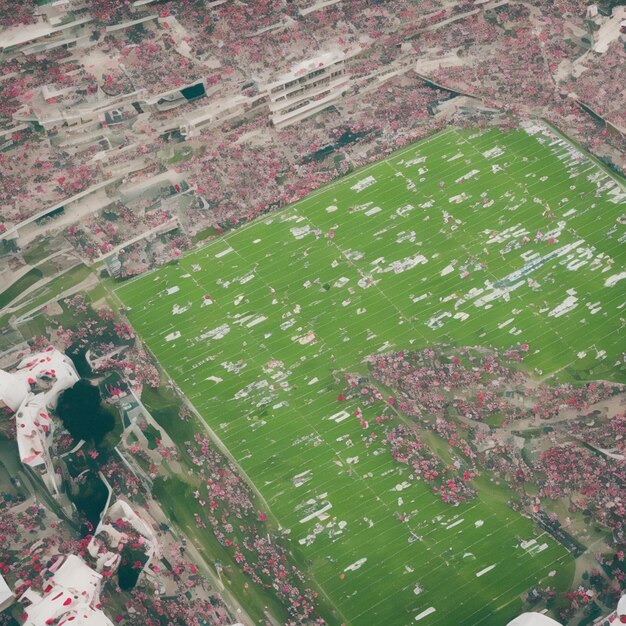How Data Analytics Is Revolutionizing NFL Scouting: Insider Insights

Data analytics is transforming NFL scouting by providing teams with objective, data-driven insights to evaluate player performance, predict potential, and make more informed decisions in the draft and free agency.
The NFL, a league synonymous with tradition and gridiron grit, is undergoing a silent revolution. Data analytics is no longer a peripheral tool but rather a central force reshaping how teams scout, evaluate, and ultimately select their future stars. This shift is driven by the increasing availability of data and the realization that traditional scouting methods can be augmented, and in some cases, outperformed, by statistical analysis.
The Evolution of NFL Scouting: From Gut Feeling to Data-Driven Decisions
For decades, NFL scouting relied heavily on subjective assessments. Scouts traveled the country, watching countless hours of game film and attending college games, relying on their experience and “gut feeling” to identify talent. While experience remains valuable, the rise of data analytics has added an objective layer to the evaluation process, challenging traditional norms and creating a more nuanced understanding of player potential.
The Rise of Advanced Metrics
The modern era of NFL data analytics began with the collection and analysis of basic statistics like yards, touchdowns, and completion percentages. However, the field has rapidly evolved to incorporate more sophisticated metrics, such as Adjusted Net Yards per Attempt (ANY/A), Pro Football Focus (PFF) grades, and Next Gen Stats. These advanced metrics provide a more granular and context-aware assessment of player performance.
Challenging Traditional Notions
- Quantifying Intangibles: Data analytics can help quantify traditionally “intangible” qualities, such as leadership, work ethic, and adaptability, by analyzing a player’s behavior and performance patterns over time.
- Identifying Hidden Gems: Advanced metrics can uncover overlooked talent by identifying players who may not have gaudy traditional statistics but possess specific skills or traits that translate well to the NFL.
- Reducing Bias: Data-driven evaluations can help mitigate biases that may influence traditional scouting methods, such as favoring players from high-profile universities or conforming to preconceived notions about positional archetypes.
The integration of data analytics into NFL scouting isn’t about replacing traditional methods entirely. Rather, it’s about creating a more comprehensive and objective evaluation process that combines the insights of experienced scouts with the power of statistical analysis. This hybrid approach allows teams to make more informed decisions and gain a competitive edge in talent acquisition.

How Teams Are Integrating Data Analytics into Their Scouting Process
NFL teams are adopting various strategies to incorporate data analytics into their scouting departments. These approaches range from hiring dedicated data scientists to training existing scouts in statistical analysis. The key is to find a system that effectively integrates data into the team’s overall scouting philosophy.
Building a Data Analytics Team
Many NFL teams now employ dedicated data analytics teams consisting of data scientists, statisticians, and software engineers. These teams are responsible for developing proprietary metrics, building predictive models, and providing data-driven insights to the coaching staff and front office.
Training Scouts in Data Analysis
Some teams are investing in training their traditional scouts in data analysis techniques. This allows scouts to better understand the data and integrate it into their existing evaluation process. This approach can bridge the gap between the “eye test” and the statistical analysis, leading to more informed decisions.
Collaboration Between Scouts and Analysts
The most successful teams foster collaboration between their scouts and data analysts. This ensures that data-driven insights are considered alongside traditional scouting reports, creating a more holistic view of each player. Regular communication and feedback loops are essential for this collaboration to thrive.
By strategically integrating data analytics into their scouting process, teams can gain a deeper understanding of player potential, identify hidden gems, and reduce the risk of making costly mistakes in the draft and free agency.
Key Metrics and Analytics Used in NFL Scouting
The world of NFL data analytics is filled with a dizzying array of metrics and statistical models. However, some key metrics have emerged as particularly valuable tools for evaluating player performance and predicting future success. Understanding these metrics is crucial for grasping how data analytics is changing the landscape of NFL scouting.
Adjusted Net Yards per Attempt (ANY/A)
ANY/A is a quarterback efficiency metric that incorporates passing yards, touchdowns, sacks, and interceptions into a single number. It provides a more comprehensive assessment of a quarterback’s performance than traditional metrics like completion percentage or passer rating.
Pro Football Focus (PFF) Grades
PFF grades are subjective evaluations of individual player performance on every play of every game. PFF analysts assign grades based on a player’s execution, impact, and overall contribution to the team’s success. These grades offer a granular and nuanced view of player performance that goes beyond traditional statistics.
Next Gen Stats
Next Gen Stats utilize sensors in players’ shoulder pads and around the stadium to track their movements, speed, and acceleration in real-time. This data is used to create advanced metrics such as average separation, time to throw, and yards after catch, providing insights into player performance that were previously impossible to obtain.

These key metrics, along with a host of other data analytics tools, are empowering NFL teams to make more informed decisions about player evaluations, roster construction, and game-day strategy. The ability to quantify performance and predict potential is becoming increasingly crucial in the competitive landscape of the NFL.
The Impact of Data Analytics on the NFL Draft
The NFL Draft is arguably the most critical event of the offseason, as teams select the players who will shape their future success. Data analytics is playing an increasingly significant role in the draft process, helping teams identify the prospects who are most likely to thrive at the professional level.
Predictive Modeling
Teams are using data analytics to build predictive models that estimate a player’s probability of success in the NFL. These models consider a wide range of factors, including college statistics, athletic testing results, and even biographical information, to generate a projected draft grade and forecast future performance.
Identifying Value Picks
Data analytics can help teams identify “value picks” by highlighting players who are being undervalued by the consensus scouting community. These players may possess specific skills or traits that make them a good fit for a particular team’s scheme, or they may simply be overlooked due to biases in traditional scouting methods.
Mitigating Risk
- Injury Prediction: Analyzing medical data and injury history can help teams assess a player’s risk of future injuries, allowing them to make more informed decisions about whether to invest a high draft pick in that player.
- Character Concerns: Data analytics can be used to identify players with potential off-field issues by analyzing their social media activity, background checks, and other sources of information.
- Bust Potential: Predictive models can help teams identify players who are at high risk of “busting” in the NFL by analyzing their performance patterns and identifying red flags that may not be apparent through traditional scouting methods.
By leveraging data analytics, NFL teams can make more informed and strategic decisions in the draft, increasing their chances of landing future stars and building a championship-caliber roster.
The Ethical Considerations of Data Analytics in NFL Scouting
While data analytics offers numerous benefits to NFL scouting, it also raises important ethical considerations. Teams must be mindful of the potential for bias in data, the privacy of player information, and the impact of data-driven decisions on individual careers.
Bias in Data
Data is only as good as the information it contains, and if that information is biased, the resulting analysis will also be biased. Teams must be careful to identify and mitigate biases in their data sources, such as historical statistics that may reflect systemic inequalities in college football.
Privacy Concerns
Teams collect a vast amount of data on prospective players, including medical records, academic transcripts, and even social media activity. It is crucial that this data is handled responsibly and ethically, with respect for the privacy of individual players.
Impact on Individual Careers
Data-driven decisions can have a significant impact on individual careers, as players are evaluated, drafted, and ultimately judged based on their statistical performance. Teams must be mindful of the human element and avoid reducing players to mere numbers.
Navigating these ethical considerations is essential for ensuring that data analytics is used responsibly and fairly in NFL scouting. By prioritizing transparency, accountability, and respect for individual players, teams can harness the power of data analytics while upholding the integrity of the game.
The Future of Data Analytics in NFL Scouting
The integration of data analytics into NFL scouting is still in its early stages, and the future holds even more exciting possibilities. As data collection becomes more sophisticated and analytical techniques become more advanced, we can expect data analytics to play an even greater role in shaping the landscape of the NFL.
Increased Use of AI and Machine Learning
AI and machine learning algorithms are already being used to analyze vast amounts of data and identify patterns that would be impossible for humans to detect. In the future, we can expect these technologies to become even more prevalent in NFL scouting, helping teams make more accurate predictions and gain a deeper understanding of player potential.
Virtual Reality Training
Virtual reality (VR) is emerging as a powerful tool for training and evaluating players. VR simulations can replicate game-like scenarios, allowing teams to assess a player’s decision-making, reaction time, and overall cognitive abilities. This technology offers a unique and objective way to evaluate players in a controlled environment.
Personalized Scouting Reports
As data analytics becomes more sophisticated, we can expect the emergence of personalized scouting reports that are tailored to each team’s specific needs and preferences. These reports will provide a customized analysis of each player, highlighting their strengths and weaknesses and assessing their fit within the team’s overall scheme.
The future of data analytics in NFL scouting is bright, with the potential to revolutionize how teams identify, evaluate, and develop talent. By embracing these advancements and using data responsibly, NFL teams can gain a significant competitive edge and build a winning tradition.
| Key Point | Brief Description |
|---|---|
| 📊 Data-Driven Scouting | NFL teams use data analytics to evaluate player performance objectively. |
| 💎 Identifying Hidden Gems | Advanced metrics uncover undervalued talent overlooked by traditional scouting. |
| 🏈 NFL Draft Impact | Data analytics aids in predictive modeling and mitigating draft risks. |
| 🤖 Future of Scouting | AI and VR will personalize scouting, enhancing player evaluation. |
Frequently Asked Questions
▼
Data analytics brings an objective approach to NFL scouting, complementing traditional methods. Teams now use advanced metrics to evaluate player performance and predict potential, leading to more informed decisions in the draft and free agency.
▼
Key metrics include Adjusted Net Yards per Attempt (ANY/A) for quarterbacks, Pro Football Focus (PFF) grades for individual performance, and Next Gen Stats for real-time tracking of player movements and speeds.
▼
Data analytics helps teams build predictive models to estimate a player’s success probability. It aids in identifying value picks and mitigating risks, such as injury potential and character concerns, ensuring smarter draft choices.
▼
Ethical considerations include addressing bias in data, protecting player privacy, and ensuring fair evaluation that respects individual potential rather than just statistical performance. Transparency and accountability are crucial.
▼
The future includes increased use of AI and machine learning for data analysis, virtual reality training simulations, and personalized scouting reports tailored to each team’s specific needs, enhancing overall scouting precision.
Conclusion
As the NFL continues to evolve, the role of data analytics in scouting will only become more prominent. By embracing these advancements and using data responsibly, teams can gain a significant competitive advantage, build stronger rosters, and ultimately achieve greater success on the field. The fusion of traditional scouting expertise with data-driven insights is the key to unlocking the next level of NFL talent evaluation.





